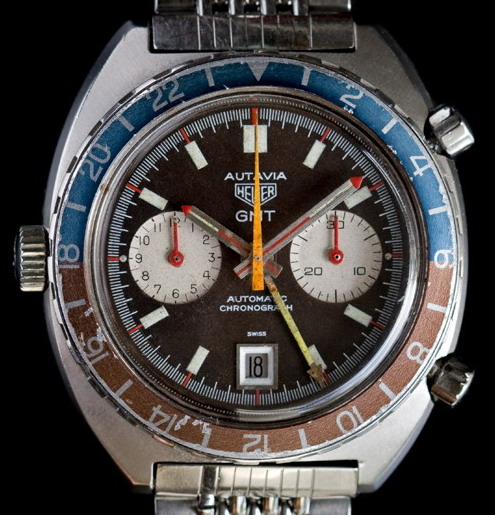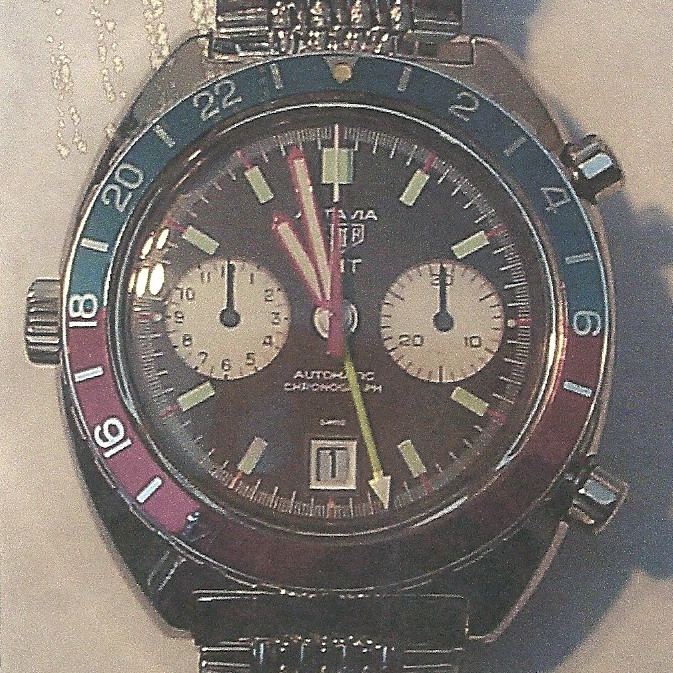We sometimes puzzle about the smallest details of the vintage Heuers, from the shape of the serifs to the grain in the “midnight blue” paint. We often construct theories — or even guess — as to why certain elements were changed, from one execution of a watch to the next. But every once in a while, we receive some rock-solid information that explains one of these changes. Shown below is an e-mail message that I received explaining why the little red chronograph needles on one execution of the Autavia Reference 1163 GMT were changed to little black needles.
Dear Jeff:
I have studied your website on Heuer chronographs for some time, and enjoy the exceptional information. Many thanks for publishing this website; I am happy to be able to make a small contribution to the information that you present to the enthusiasts. This information relates to the two tiny needles on the Autavia 1163 GMT chronograph . . . the needles that were red for a short time, and then switched back to black.
I was first introduced to Heuer chronographs back in 1967 by my friend’s father in Switzerland. He was in the industrial timer business and had just taken up flying. He showed me his newly acquired Autavia 12 and told me that this is the watch to own. I bought one and later I purchased the GMT version and both models served me well. In 1972, I bought the GMT Automatic (sample photo shown below) since it offered a date.
I was very happy with the watch, and as a matter of fact two friends of mine ordered the same model for themselves. However, there was a drawback to my Autavia GMT, and it showed itself during night operation. I was working as an air taxi pilot and flight instructor in general aviation. All the airplanes that I flew use red cockpit lighting for night operation to preserve the night vision of the pilots — a practice that was followed over the years in all airplanes. I noticed that — under the red lighting — the red chronograph needles “disappeared” against the white background (which took on the red tint from the lighting). This made it impossible to see the needles to time approaches or any other events. So for night operation in a cockpit, this version of the Autavia GMT, with the red needles, was unacceptable. (I never had this problem with my older Autavias, because they had standard black chronograph needles.)
I was living in the United States at the time and returned the Autavia GMT to Heuer in Springfield N.J. with a full explanation and ask them to inform Heuer Switzerland as well. I suggested that because these chronographs were being used in cockpits, they should make the dials readable under all lighting conditions. I suggested that Heuer should stop installing the red chronograph hands. Contrast is important for easy reading under dim light conditions and white on black or black on white works the best.
I received my Autavia GMT back saying that Heuer appreciated the feedback and they would not install red chronograph needles on Autavias in the future. They changed the hour and minute chronograph needles, to get rid of the red, and you will notice that they also changed the main time of day hands, with the brushed steel hands being replaced by the red-edged hands. This was a good improvement, as the red-edged time-of-day hands, with the lume inside, are easier to see in a dim cockpit. They left the 24 hour GMT hand, as it was (in yellow), which was fine. The conversion was done at no cost to me and I am happy to say that since then I have not seen an Autavia model with red hands.
This is why it may be hard to establish a time of production without knowing the history behind this GMT. So far, this watch has been overhauled twice by Heuer and it has always come back with the same hand configuration. (Notice that my Autavia has no red segments on the minute recorder; the dial is original and was never changed.)
I also bought the Reference 11630 Autavia GMT model, but most often I wear the 1163.
In closing, I would like to thank you for your effort in providing all this information about these fine timepieces and I hope that my letter can shed some light or add some history to the Heuer story on your website for all the Autavia owners.
Respectfully Yours,
Heinz Rengel
++++++++++++++++++++++++++++++++++
Special thanks to Heinz for sharing this very interesting story that explains one small detail in the history of the Heuer chronographs.


